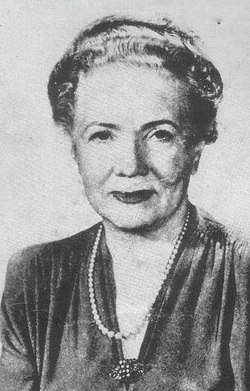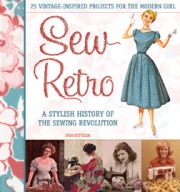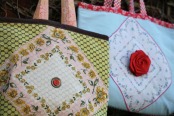First, thanks for the great shout out on the Sew Retro blog! She said such nice things about my book. I admit, when I discovered this blog (after the book was already named), I was a little nervous. But I’m glad that she saw that my Sew Retro wasn’t meant in any way to compete or steal thunder from her awesome blog (which I absolutely love, by the way!).
Okay, it’s the start of week four with the baby, and things are settling into a sort-of routine. I’ve been able to work for a few hours each morning and afternoon, which is just enough to keep up with the half-dozen or so story assignments I have. My body is getting used to functioning on less sleep, too, though I’m hoping that Georgia follows in the footsteps of her brother, Max, and sleeps through the night around six weeks.
All of this working my schedule around my kids’ schedule has got me thinking about how crafty women have been doing this for years, and how finding the balance between family and work has replayed itself again and again in each generation. Today, we have fabulously successful bloggers, fabric and pattern designers, and Etsy sellers, who also devote equal time to taking care of their families. It makes me think about the Women’s Domestic Institute, a correspondence school in Scranton, Pennsylvania that began sometime in the 19-teens, and was led for many years by Mary Brooks Picken (I have a bio sketch of her in the book). 
Mary Brooks Picken
Through the Institute, women received sewing lessons through the mail and learned the basics of making hats, garments, and accessories. Picken (1886 – 1981) was really a visionary: she saw that ready-made garment sales were picking up steam and that fewer women were sewing. She really helped to re-brand sewing: instead of sewing being old-fashioned, she showed that it was a viable way for a woman to run a lucrative and fulfilling home-based business. Picken promoted the work-at-home seamstress lifestyle as a way for women who took care of the home and kids to make their own money. An Institute brochure from 1923 says: “Through the Women’s Institute, the way is open for any women to fit herself right in her own home, without interrupting her daily duties, to become financially successful and independent as a dressmaker.” Picken helped women see that sewing could be empowering, not just from an artistic perspective, but also financially (and many women did report making good money putting their seamstress skills to work). Picken is an inspiration all around: she was incredibly prolific, writing 96 books about all manner of domestic arts, but mostly about sewing.
It’s really not much different than what this generation of mommy-preneurs is doing, as we find the balance between family and career. It’s challenging and frustrating and rewarding, but I take comfort in knowing that scores of women before me have figured it out!



 RSS Feed
RSS Feed